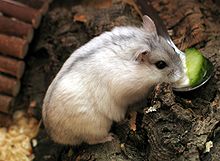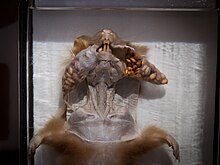Cricetinae
The cricetins (Cricetinae) are a subfamily of rodents, commonly known as hamsters (a Germanism). Nineteen have been identified extant species, grouped into seven genera. Most are native to the Middle East and the southeastern United States. All species are characterized by expandable pouches, called pouches, located inside the mouth and running from the cheeks to the shoulders. Being very easy to breed in captivity, they are widely used as laboratory animals and as pets.
Current species
Taxonomists generally disagree about the most appropriate placement of the subfamily Cricetinae within the superfamily Muroidea. Some place it in a family Cricetidae that also includes voles, lemmings, and New World rats and mice; others group all of these into a large family called Muridae. Its evolutionary history is recorded by fifteen extinct fossil genera and dates back 11.2 million to 16.4 million years to the Middle Miocene epoch in Europe and North Africa; in Asia it ranges from 6 to 11 million years. Four of the seven living genera include extinct species. An extinct Cricetus hamster, for example, lived in North Africa during the middle Miocene, but the only extant member of that genus is the European or Eurasian common hamster.
- Gender: Allocricetulus
- Allocricetulus curtatus (Allen, 1925) - Mongol Hamster.
- Allocricetulus eversmanni (Brandt, 1859) - Eversmann Dwarf Hamster
- Gender: Cansumys
- Cansumys canus (Allen, 1928) - Gansu Hamster
- Gender: Cricetus
- Cricetus cricetus (Linnaeus, 1758) - Hámster vulgar, is the largest, measuring between 20 and 35 centimeters long, with a tail ranging between 2 and 5 cm long, being occasionally a plague in the European valleys in ancient times, in which it is still in the wild state.
- Gender: Cricetulus
- Cricetulus alticola (Thomas, 1917) - Tibetan dwarf Hamster
- Cricetulus barabensis (Pallas, 1773) - Chinese Hamster scratched, the only hamster with a prensil queue, which usually measures about 4 cm (most hamsters have very short queues and not prensils). The size and overall appearance more similar to that of a mouse make their real or non-genic Phodopus subject to debate.
- Cricetulus griseus (Milne-Edwards, 1867) Chinese Hamster
- Cricetulus kamensis (Satunin, 1903) - Kam dwarf Hamster
- Cricetulus longicaudatus (Milne-Edwards, 1867) - Long-tailed dwarf Hamster
- Cricetulus migratorius (Pallas, 1773) - Migratory Hamster
- Cricetulus sokolovi (Orlov & Malygin, 1988) - Socolov dwarf Hamster
- Gender: Mesocricetus
- Mesocricetus auratus (Waterhouse, 1839) - Gold or Syrian Hamster, can measure about 15 cm, is native to Syria. Its most common coat is of a light brown tone, although they are sometimes made of light yellow coat, but in animal shops you can receive very different names according to their colouring. There are some varieties of the species with different traits, such as a longer hair, which can reach several cm and usually require special care. Gold hamsters are very territorial, and usually fight to death if they stay in the same cage with other members of their species.
- Mesocricetus brandti (Nehring, 1839) - Turkish Hamster
- Mesocricetus newtoni (Nehring, 1898) - Romanian Hamster
- Mesocricetus raddei (Nehring, 1894) - Golden Hamster of the Caucasus
- Gender: Phodopus
- Phodopus campbelli (Thomas, 1905) - Campbell's dwarf Hamster.
- Phodopus robrovskii (Satunin, 1903) - Roborovski dwarf hamster (or desert), only 4 or 5 cm and extremely hyperactive. His coat is brown.
- Phodopus sungorus (Pallas, 1773) - Russian dwarf Hamster, white, winter or hamster of Zungaria. It is usually confused with Campbell's dwarf hamster, similar though slightly smaller; both have half the size of the golden hamster. The winter hamster receives its name because of the color changes of its fur: usually from a grayish tone during the winter, when the sunlight is reduced to eight hours a day or less, the winter hamster changes the color of its fur to an almost uniform white tone.
- Gender: Tscherskia
- Tscherskia triton (From Winton, 1899) - Long tail large Hamster
Etymology
The name "hamster" is a loan word from German, which in turn is derived from earlier Middle High German hamastra. Possibly related to Old Church Slavonic khomestoru, which is a mixture of the Russian root хомяк (khomyak) "hamster" and a Baltic word (Lithuanian staras "hamster"); or of Persian origin (Avestan hamaēstar "oppressor"). The collective noun for a group of hamsters is "horde".
General characteristics
- Life expectancy: from year to half to three years. There are slight variations according to the species, but their life expectancy generally does not exceed four years. Still, specimens have been known to have reached seven years. They influence to a large extent factors such as food or the environment in which they live, as well as being pending and detecting any disease on time. Generally, the smaller the species, the less its longevity.
- Adult weight: 30-40 g in Russians; 100-180 g the golden hamster.
- Length: 8-10 cm Russian; 15-18 cm golden hamster.
- Sexual maturityTwo and a half months.
- He enters the stage of jealousy: (after two months) every four days.
- gestation timebetween eighteen and twenty-one days the Russians and fifteen to seventeen days the golden hamsters.
- Childbirth: average of seven to eight. Cases of nineteen were known.[chuckles]required]
- Age of weaning: between three and four weeks.
Behavior
Food
A behavioral characteristic of hamsters is hoarding. They carry food on their broad cheeks to their underground storage chambers. When full, the cheeks can make their heads double or even triple in size. Hamsters lose weight during the fall months in anticipation of winter. This occurs even when hamsters are kept as pets and is related to increased exercise.
Social behavior
Most hamsters are strictly solitary. If housed together, acute and chronic stress can occur, and they may fight fiercely, sometimes to the death. Dwarf hamster species can tolerate siblings or unrelated hamsters of the same sex if introduced at a young enough age, but this cannot be guaranteed. Hamsters communicate through body language with each other and even with their owner. They communicate by sending out a specific scent using their scent glands, and they also use body language to express how they feel.
Chronobiology
Hamsters can be described as nocturnal or crepuscular (mainly active at dawn and dusk). Khunen writes, "Hamsters are nocturnal rodents that are active at night...", but others have written that because hamsters live underground for most of part of the day, they only come out of their burrows for about an hour before sunset, and then return. when it gets dark, its behavior is mainly crepuscular. Fritzsche noted that although some species have been observed to show more nocturnal activity than others, all are primarily crepuscular.
In the wild, Syrian hamsters can hibernate and allow their body temperatures to drop close to room temperature. This type of thermoregulation lowers the metabolic rate to approximately 5% and helps the animal greatly reduce its need for food during the winter. Hibernation can last up to a week, but more often it lasts two to three days. When kept as a house pet, the Syrian hamster does not hibernate.
Digging Behavior
All hamsters are excellent burrowers, building burrows with one or more entrances, with galleries connected to chambers for nesting, food storage, and other activities. They use their front and hind legs, as well as their snouts and teeth, to dig.. In the wild, the burrow buffers environmental temperature extremes, offers relatively stable weather conditions, and protects against predators. Syrian hamsters dig their burrows generally to a depth of 0.7 m. A burrow includes a steep entrance tube (4–5 cm in diameter), a nest and accumulation chamber, and a blind branch for urination. Laboratory hamsters have not lost their ability to dig burrows; in fact, they will do so with great vigor and skill if given the proper substrate.
Wild hamsters will also appropriate tunnels made by other mammals; the Djungarian hamster, for example, uses pika paths and burrows.
Playback
Fertility
Hamsters become fertile at different ages depending on their species. Both Syrian and Russian hamsters mature quickly and can start breeding at a young age (4-5 weeks), while Chinese hamsters usually start breeding at two to three months of age and Roborovski dwarf hamsters at three. or four months old. The reproductive life of the female lasts about 18 months, but male hamsters remain fertile much longer. Females are in heat approximately every four days, indicated by reddening of the genital areas, a musky odor, and a hissing, squeaky vocalization she makes if she thinks a male is nearby.
When viewed from above, a sexually mature female hamster has a clipped tail line; The tail line of a male protrudes on both sides. This may not be very visible in all species. Male hamsters often have very large testicles in relation to their body size. Before sexual maturity occurs, it is more difficult to determine the sex of a young hamster. When examined, female hamsters have their anal and genital openings close together, while males have these two openings further apart (the penis is usually retracted into the fur and therefore appears as a hole or pink pimple).).
Pregnancy and fertility
Syrian hamsters are seasonal breeders and will produce several litters a year with several young in each litter. The breeding season is from April to October in the Northern Hemisphere, with two to five litters of one to 13 pups being born after a gestation period of 16 to 23 days. Dwarf hamsters breed year-round. Gestation lasts 16-18 days for Syrian hamsters, 18-21 days for Russian hamsters, 21-23 days for Chinese hamsters, and 23-30 days for Roborovski hamsters. The average litter size for Syrian hamsters is about seven pups, but can be as high as 24, which is the maximum number of pups the uterus can hold. Campbell's Dwarf Hamsters tend to have four to eight pups in a litter, but can have as many as 13. Winter White Hamsters tend to have slightly smaller litters, as do Chinese and Roborovski hamsters.
Intersex assault and cannibalism
Female Chinese and Syrian hamsters are known to be male-aggressive if they stay together for too long after mating. In some cases, male hamsters can die after being attacked by the female. If breeding hamsters, separation of the pair after mating is recommended, or they will attack each other.
Female hamsters are also particularly sensitive to disturbances during childbirth, and may even eat their own young if they believe they are in danger, although sometimes they only carry the young on their cheeks. If female hamsters captives are left for extended periods (three weeks or more) with their litter, they can cannibalize the litter, so the litter should be removed by the time the young are able to feed and drink independently.
Weaning
Hamsters are born blind and hairless in a nest that the mother will have prepared beforehand. After a week, they begin to explore outside the nest. Hamsters are capable of producing litters every month. Hamsters can be bred after three weeks of age. It can be difficult for babies not to depend on their mother for breastfeeding during this time, so it is important that they are provided with food to ease the transition from breastfeeding to self-feeding. Once the hamsters reach three weeks of age, they are considered mature.
Longevity
Syrian hamsters do not usually live more than two or three years in captivity and less in the wild. Russian hamsters (Campbell's and Djungarian) live between two and four years in captivity, and Chinese hamsters between two and a half and three years. The smallest Roborovski hamster usually lives up to three years in captivity.
Contenido relacionado
Theobromine
Struthio camelus
Lophotrochozoa







